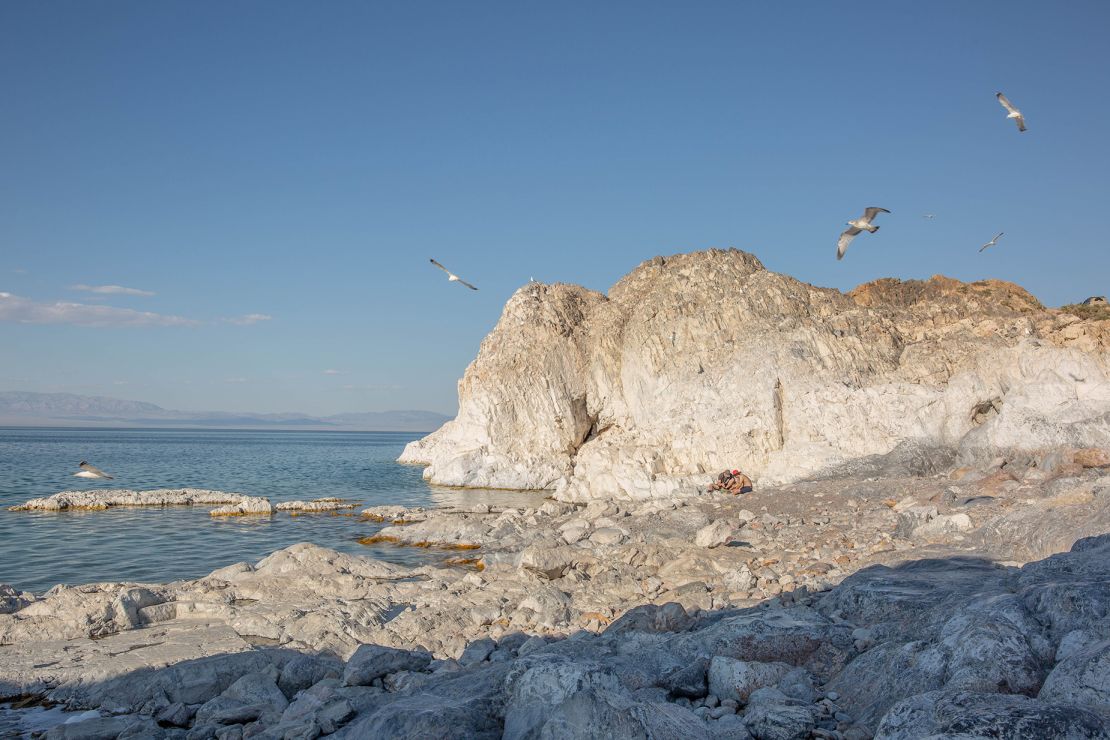Editor’s note: This CNN travel series is or has been sponsored by the country it covers. CNN retains full editorial control over the subject matter, coverage and frequency of articles and videos within the scope of the sponsorship, in accordance with our policies.
Lake Khyargas, Mongolia
CNN
—
A trip from the capital Ulaanbaatar to Lake Khyargas in western Mongolia is not for the faint of heart.
The journey is about 1,800 kilometers (about 1,118 miles) long and can take between one and three days, depending on how confident you feel behind the wheel on this country’s challenging roads.
And then there’s the weather – it’s not uncommon to experience three seasons in one afternoon while road ripping in Mongolia.
Once you reach the lake, it is another 43 kilometers over bumpy roads, some of which are covered with deep sand, until you reach the lake’s most famous landmark: Khetsuu Khad.
But the trip is more than worth it – especially at a time when stories and images of overcrowded destinations and annoyed locals continue to dominate headlines around the world.
Known for its whitewashed cliffs and crystal-clear waters, this little-known spot in Mongolia makes visitors feel more like they are in the Mediterranean than a remote corner of Asia.
“Lake Khyargas is one of Mongolia’s best-kept secrets,” says outdoor enthusiast and Ulaanbaatar local Uyanga Vladimir of TIC 4×4 and Outdoor, who shares photos of his travels on Instagram at @uvtravels.
“The uniqueness of the landscape and rock formations that surround the area compared to what one would normally expect to see in other regions of the country is fascinating. Lake Khyargas looks and feels more like Greece than anything else. It is almost out of this world.”
When you join the few locals who swim in these magical waters, you feel like you are experiencing something special. This unspoiled, rugged beauty is part of the lake’s charm and makes the experience even more unforgettable.
But according to Vladimir, it is not just the landscape that is out of this world.
“There is a legend that says that a huge blue bull lives in the depths of Lake Khyargas,” he explains. “Every autumn, the bull rises from the bottom of the lake to visit just a few herding families and bless them with abundant livestock for the coming year.”

One of several saltwater lakes in the country, Khyargas is located in the northwestern province of Uvs and flows into the Zavkhan River basin, an area known for its semi-desert climate. (You’re more likely than likely to see the country’s famous Bactrian camels roaming the lake’s shores.)
With a length of 74 kilometers, a width of 31 kilometers and a depth of 80 meters, it is the third largest lake in Mongolia.
Khetsuu Khad, the main attraction, is a natural rock formation that stretches along the east coast. If you want to go there on your own, a 4×4-capable SUV that can handle deep sand is highly recommended. (Just ask all the Prius drivers who seem to get rescued on an hourly basis.)
Alternatively, boats run from the northern shore of the lake to Khetsuu Khad, a popular beach and camping site.
There are a few lodges on the lake, including Khetsuu Khad Tourist Camp and Baruun Beach Resort. Both are 43 kilometers from the main road to Khyargas. The drive can take up to two hours, depending on whether you get stuck in the dunes.
There is also a free camping site in front of Khetsuu Khad, which is very popular with the locals.
Although there is no official entrance or designated ranger station, officials roam around the lake and charge you a modest entrance fee of 9,000 tugrik, or less than $3, as they walk around.
There are several hot springs around the lake, and natural springs further north.

For bird lovers, the shores of Lake Khyargas, especially Khetsuu Khad, are a great attraction.
Several globally threatened species can be found here. On a morning observation tour you can see Dalmatian pelicans, bar-headed geese, great crested grebes, cormorants, black vultures, little owls, kestrels, whitethroats, Siberian stonechats, Isabelline and desert wheatears as well as house and rock sparrows.
Migratory birds arrive at the lake in April and depart in mid-September. Travellers come mainly to see the large, round cormorant nests on the cliffs of Khetsuu Khad, where they lay and incubate their eggs.
There is also an abundance of fish species such as Mongolian grayling, Altai leuciscinae, Ottoman sea bream and dace – all of which are an excellent source of food for the birds.
As mentioned above, the journey from Ulaanbaatar to Lake Khyargas is long. Eager travelers could reach it within a day, but it is more realistic to expect two to three days to cover the 1,800 kilometers.
Alternatively, travelers can fly from Ulaanbatar to Ulaangom, the capital of Uvs Province, which is only 220 kilometers from the lake. Several tour operators offer trips to the region that include visits to the lake.
Uvs in the northwest near the Russian border is the largest province in Mongolia and also one of the most diverse. There are not only picturesque lakes here; snow-capped mountains and dry deserts also make this part of the country unique.
Immersing yourself in the rugged roughness of this remote corner of Mongolia, one can’t help but compare the experience to the crowded destinations many have visited this summer. This time of year has seen plenty of news of Spanish towns penalizing tourists for claiming beach space or shooting water guns at them in the street, and Japanese authorities being forced to crack down on an influx of visitors to Mount Fuji – to name just a few incidents.
This is a nice reminder that while Mongolia’s lesser-known natural wonders may not be easily accessible, they are great alternatives to some of the world’s famous destinations that are becoming increasingly difficult to enjoy.

